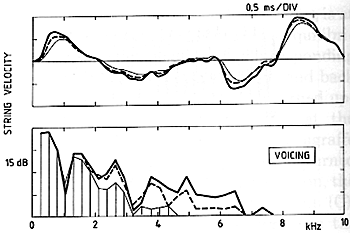 Fig. 19. Effects of voicing (C4, mf), showing the changes in waveform and spectra when a hammer which initially is much too hard (full line), is needled to normal stiffness (dashed line), and eventually "ruined" (thin line).
Fig. 19. Effects of voicing (C4, mf), showing the changes in waveform and spectra when a hammer which initially is much too hard (full line), is needled to normal stiffness (dashed line), and eventually "ruined" (thin line).

[<- Previous] [Contents of this lecture] [Next ->]
The spectral properties can also be influenced by the piano technician. By a procedure called voicing, in which the hammer felt is treated with needles, the technician gradually works out the optimum stiffness of the felt. Not surprisingly, this procedure gives smaller changes than the preceding experiment with exchanged hammers (see Fig. 19).
 Fig. 19. Effects of voicing (C4, mf), showing the changes in waveform and spectra when a hammer which initially is much too hard (full line), is needled to normal stiffness (dashed line), and eventually "ruined" (thin line).
Fig. 19. Effects of voicing (C4, mf), showing the changes in waveform and spectra when a hammer which initially is much too hard (full line), is needled to normal stiffness (dashed line), and eventually "ruined" (thin line).
In this experiment, a hammer which initially was much too hard was softened in steps until it was destroyed. While the changes may appear very small as viewed in the string waveform, the spectral changes are in fact substantial, reducing the upper limit of the spectra from about 8 kHz to approximately 4 kHz.
By normal playing, the felt gradually compresses and the strings introduce grooves in the hammer surface. Once in a while - the keener the pianist, the more frequently - the instrument is ready for a reshaping of the hammers (in which the outer layers of felt are removed by filing), followed by a voicing. Since a proper voicing procedure is not reversible - the hammer cannot be made harder in a satisfactory way once it has been needled too much - it is strongly recommended to always consult an authorized piano technician.
[<- Previous] [Top] [Contents of this lecture] [Next ->]
This lecture is one of Five lectures on the Acoustics of the piano
© 1990 Royal Swedish Academy of Music